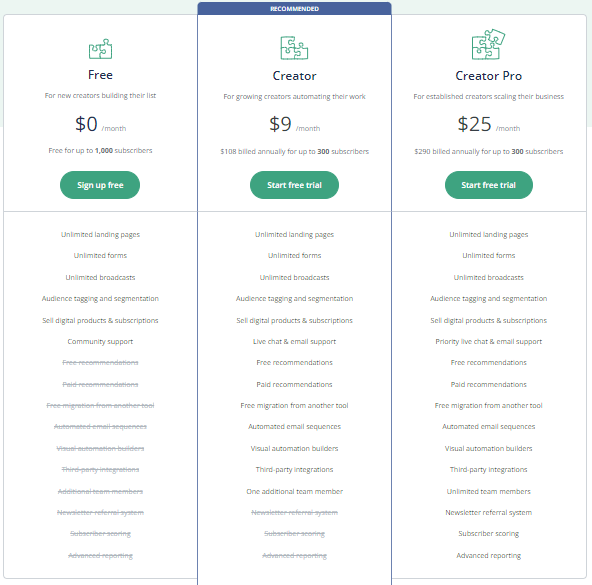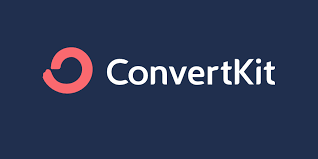Discover Convertkit With This Convertkit Review
In the rapidly evolving landscape of digital marketing, this convertkit review reveals it as a formidable email marketing solution tailored for online creators like bloggers, podcasters, and content creators. This platform stands out for its focus on simplicity, user-friendliness, and effectiveness, presenting itself as a compelling choice for individuals aiming to expand their audience and monetize their creative endeavors. Herein, I delve into an extensive examination of ConvertKit, discussing its principal features, advantages and disadvantages, my own experiences with the platform, its pricing structure, and additional pertinent aspects.
Table of Contents
Convertkit Features
ConvertKit is rich in features tailored to meet the needs of modern online creators. At its core, it offers robust email marketing capabilities, including the creation of sign-up forms and landing pages to help users grow their mailing lists. Automation tools are another highlight, enabling users to set up complex email sequences triggered by subscribers’ actions, thereby increasing engagement and personalization. ConvertKit also offers segmentation features, allowing creators to categorize subscribers based on their interests, behavior, and interaction with content. This ensures that the content delivered is highly targeted and relevant. Additionally, the platform provides detailed analytics to track the performance of email campaigns, subscriber growth, and engagement metrics.
Convertkit Key Features
- Email Marketing: ConvertKit offers email marketing tools that allow users to send broadcast emails, create email sequences, and automate the delivery of personalized content based on subscriber actions.
- Automation: With ConvertKit, creators can set up automated email funnels that guide subscribers through customized paths based on their interactions, such as email opens, clicks, and website visits. This enables highly targeted and effective communication.
- Landing Pages and Forms: Users can create beautiful landing pages and signup forms without needing any coding knowledge. These tools are designed to convert visitors into subscribers by offering free content, product updates, or other incentives.
- Commerce: ConvertKit includes commerce features that enable creators to sell digital products and subscriptions directly to their audience. This integrated approach simplifies the process of monetizing content and services.
- Subscriber Management: The platform offers sophisticated subscriber management and segmentation capabilities, allowing users to organize their audience based on interests, engagement, and other criteria to ensure relevant communication.
- Integrations: ConvertKit integrates with a wide array of other tools and platforms, including e-commerce systems, membership sites, and social media platforms, enhancing its functionality and the ability to streamline creators’ workflows.
- Analytics: ConvertKit provides detailed analytics on email campaign performance, subscriber growth, and conversion rates, helping creators understand their audience better and optimize their strategies for growth.

Convertkit Pros & Cons
Pros
- User-Friendly Interface: ConvertKit’s dashboard and overall design are intuitive, making it easy for beginners to navigate and use the platform effectively.
- Powerful Automation: The automation capabilities are both flexible and powerful, enabling creators to set up detailed subscriber paths based on behavior and preferences.
- High Deliverability Rates: ConvertKit prides itself on ensuring that emails reach subscribers’ inboxes, maintaining high deliverability rates.
- Focused on Creators: The platform is specifically designed with the needs of online creators in mind, providing tools and features that cater to this demographic.
Cons
- Pricing: While offering a free plan, ConvertKit’s paid options can be expensive for creators just starting out or those with a limited budget.
- Limited Design Options: Compared to some competitors, ConvertKit’s email and landing page templates are more limited in design flexibility.
- Basic Reporting: Although it provides essential analytics, the reporting features may not be as advanced or detailed as those offered by some other email marketing platforms.
User Experience
Drawing from personal experience, ConvertKit has been a transformative tool in managing email marketing campaigns. The ease of setting up automations and segmenting the audience has allowed for more personalized and effective communication with subscribers. The platform’s focus on creator needs is evident in its design and functionality, which seamlessly align with the objectives of growing an engaged audience. While the pricing has been a consideration, the value derived from its features justifies the investment, especially when leveraging the platform to drive revenue through email marketing.
Convertkit Pricing
ConvertKit offers a tiered pricing structure based on the number of subscribers, starting with a free plan that includes basic features for up to 1,000 subscribers. The free plan is a great starting point for new creators, providing access to email broadcasts, landing pages, and forms. As needs grow, paid plans offer additional features such as automation, advanced reporting, and premium support. Pricing for these plans increases with the subscriber count, requiring creators to carefully consider their budget against their needs for advanced features.

Integration and Flexibility
ConvertKit integrates seamlessly with a wide range of other platforms and services, including ecommerce platforms, membership sites, and webinar tools. This integration capability is crucial for creators looking to automate their workflows and connect different aspects of their online presence. The API and Zapier integration further enhance its flexibility, allowing for custom solutions and connections with hundreds of other applications.
Community and Support
ConvertKit places a strong emphasis on community and support, offering extensive resources, tutorials, and a responsive customer service team. The platform also hosts webinars and workshops to help creators maximize their use of the platform and grow their audience. This supportive environment is invaluable, particularly for those new to email marketing or seeking to expand their skills.
Convertkit Target Audience
- Bloggers: Individuals who share content regularly on their blogs and look to grow their readership, engage with their audience, and monetize their content through email marketing.
- Content Creators: This includes YouTubers, podcasters, and social media influencers who seek to establish a more direct line of communication with their followers, distribute content, and promote their work or partnerships.
- Authors and Writers: Writers and self-published authors who want to build a loyal fanbase, promote their books, share updates about upcoming releases, and connect with readers on a personal level.
- Online Course Creators: Educators and experts who sell courses and digital products online and use email to market their courses, communicate with students, and provide value through educational content.
- Musicians and Artists: Creatives looking to promote their art, announce shows or exhibitions, sell merchandise, and share behind-the-scenes content with their fans.
- Freelancers and Consultants: Professionals who offer services and use email marketing to nurture leads, share expertise through newsletters, and keep clients informed about their offerings.
- Small Business Owners: Business owners who sell products or services online and want to use email to boost sales, announce new products or promotions, and maintain customer relationships.
- Non-Profit Organizations: Charities and non-profit entities aiming to update their supporters, drive donation campaigns, and organize events through targeted email campaigns.
- Photographers and Videographers: Visual artists who want to showcase their portfolios, offer sessions or packages, and keep clients and prospects engaged with their work.
- Coaches and Personal Trainers: Individuals offering personal development, fitness, and health coaching services who use email to provide motivational content, announce workshops, and sell coaching packages.
Conclusion
In conclusion, ConvertKit stands out as a comprehensive email marketing solution designed with the needs of online creators at the forefront. Its blend of simplicity, powerful features, and creator-focused design make it a compelling choice for anyone looking to elevate their email marketing efforts. While considerations around pricing and design flexibility may influence decision-making, the platform’s overall value proposition is strong, particularly for those committed to building and engaging with their audience through email.





